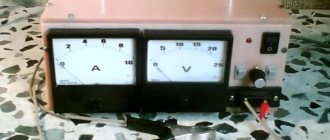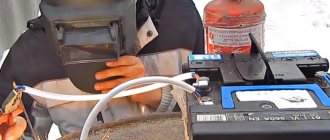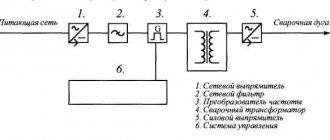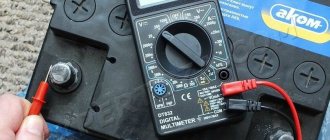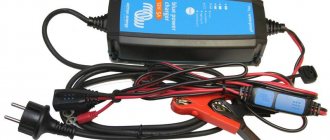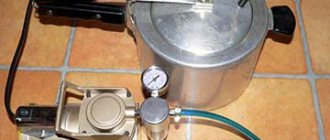It is very rare that a battery lasts exactly as long as the manufacturer intended. In such a situation, you can safely remove the battery, send it for recycling and buy a new battery.
During the operating period, it is sometimes necessary to check the condition of the battery, assess the charge level, check the electrolyte and perform other procedures.
Some people turn to specialists for help. Others prefer to do everything themselves. And in this case, you will need to have appropriate tools and devices designed for diagnostics.
Types of diagnostic devices
The general concept of testers for car batteries actually hides a fairly impressive list of control and measuring instruments.
When it comes to the need to check the condition and performance characteristics of the battery, various devices and devices are used.
You should take a closer look at the types of testers for car batteries and find out their purpose. This will allow you to understand which of the presented assortments may be useful to you, and which devices you can do without.
The type of battery plays an important role when choosing a battery tester when diagnosing your own car. For serviceable batteries, some meters are more relevant, for unserviced batteries, others are more relevant.
The general list consists of:
- multimeters;
- hydrometers;
- load forks;
- universal devices;
- capacity meters.
Typically, checking and measuring parameters are relevant when certain malfunctions occur in the battery.
Most often, motorists encounter:
- fast charging and discharging;
- inability to charge the battery;
- current leakage;
- broken circuits;
- changes in electrolyte density, etc.
Universal diagnostic devices provide the ability to check the basic parameters that the car owner may need. But electronic devices do not always help with repairs. There are parameters that cannot be checked without hydrostatic devices. A striking example is a density tester, for which the use of an electronic device is not suitable. To assess the condition of the battery under the hood of the car, you will need to use 2-3 devices at once.
Now it will be interesting to learn separately about each tester, which can certainly be useful to you for checking dead or faulty batteries under the hood of your car.
Multimeters
To begin with, it is important to focus on the fact that there are household and industrial diagnostic multimeters.
This is a fairly universal tester that allows you to find out a lot of useful information about the battery in your car.
The most popular tester. The main capabilities that multimeters have for assessing the condition of car batteries include:
- determining the presence of an open circuit;
- current measurement;
- resistance measurements;
- voltage parameters.
Multimeters themselves are either analog or digital. They differ only in the display on which information is displayed. Plus, the accuracy of digital models is slightly higher.
Analog devices are presented in the form of a tester with a pointer screen, where a measurement scale is located under the pointer. Depending on what mode the multimeter is operating in, the arrow moves to the desired scale when switching. But now analog multimeters are almost never used. This is due to their accuracy and the emergence of more advanced electronic models.
Working with a digital device is much easier. The display is presented in the form of an electronic display, where the displayed parameters change depending on the mode. The advantage of an electronic type multimeter is that it reads tenths and hundredths of the measured values. Sometimes even a deviation of a couple of tenths indicates a malfunction, but an analog device will not notice them.
The functionality of multimeters is varied. But usually they allow you to measure voltage, current, resistance, etc. You just need to switch the device to the desired mode and set the measurement interval. Plus, the devices are complemented by some options in the form of tweeters, backlight, thermocouple, color display, etc.
The more functions, the more versatile the device will be. This will allow you to find out a complete set of information using one device.
But in the case of battery maintenance, the multimeter does not have some capabilities.
If you need a tester designed to measure the capacity parameters of a car battery, then a multimeter is unlikely to help. Here it is worth using other devices.
Hydrometer
The performance of the battery largely depends on the state of the electrolyte. To take measurements, electrolyte hydrometers are used, the use of which is not difficult.
The operation of a hydrometer is based on the hydrostatic law. The higher the density of a liquid, the more it will try to push objects in it to the surface.
The hydrometer is presented in a fairly simple form. This is a flask with a pipette for collecting liquid and a bulb that creates pressure. A cylindrical glass float with a printed scale is used as a meter.
To take measurements you need:
- assemble the device according to the instructions;
- immerse the pipette in the electrolyte;
- use a bulb to collect liquid;
- Using the scale as a guide, read the values obtained.
A normal density for an electrolyte is considered to be in the range of 1.25–1.28 g/cm³. In case of deviations from the norm, it is necessary to add electrolyte or add a certain amount of distilled water.
In relation to batteries, the peculiarity of the hydrometer is that it can only be used when working with serviceable batteries. They allow you to open the cans and access the electrolyte. In the case of maintenance-free batteries, there is practically no need for a hydrometer. Unless it will be possible to check whether the declared density of the purchased electrolyte corresponds to reality.
Load fork
If we talk about load forks, these are devices necessary to determine the battery discharge rate. Thus, the motorist finds out how badly the power source is worn out.
In its simplest form, it is a voltmeter and a load resistor combined into one device. Load forks are often assembled with your own hands, but for confident and safe operation it is better to purchase a factory product.
Improved models have added various functionality. In particular, the plug can be used as a capacity tester to check the condition of a car battery.
The design is presented in the form of a metal case with a handle, wires and clamps at the end. The housing itself includes load spirals, a cylindrical rod, and a digital or analogue voltmeter display. Improved models also have an ammeter. The voltmeter is connected to a rod, which is a minus wire, and a positive wire.
You can test a car battery using a load fork with or without load:
- Without load . In this case, you must wait at least 5 hours after stopping the engine. If the battery was charging before this, then you need to wait 5-7 hours after this process is completed. Then the plus of the plug is connected to the plus on the battery, and the minus terminal goes to the tester rod. The device displays values from which appropriate conclusions are drawn.
- Under load . In this case, a load is supplied from the spirals, which simulates the start of an engine starter on a car. You cannot keep the circuit closed for more than 5 seconds. If the values obtained differ greatly from the factory ones, the battery will probably have to be changed.
The load fork is a quite useful and necessary measuring device for many motorists.
Smart solutions for battery testing
If batteries are involved in critical systems, it is best to constantly monitor them. Modern technologies come to the rescue for this:
Information acquisition module (MCI) PITE-3926С
PITE-3926C is a wireless module for transmitting information about the battery status. Thanks to it, you can remotely monitor battery parameters.
Battery monitoring system PITE-3921
The PITE-3921 system collects information from up to 14 sensors installed on batteries (depending on the modification). The information is processed by the controller and can be output directly to the mobile device via Wi-Fi. And also the data can be transmitted via the Internet to the computers of persons responsible for the condition of the batteries.
Battery monitoring system PITE-3923
PITE-3923 differs from the previous system in its ease of control, small size sensors and the number of sensors in a set up to 108 (depending on the modification). Information is transferred to mobile devices only via the Internet.
Universal devices and capacity testers
If you need to check the capacity, additionally find out the voltage parameters and other values, in this case a universal tester for car battery diagnostics will help.
Each battery has certain capacity parameters. They are indicated directly on the case in large numbers. But this is the ideal capacity that the battery receives from the factory. During long-term storage or operation, these parameters gradually (and sometimes quite quickly) decrease.
To find out what the real battery capacity is now, you should use an automatic tester.
There are several devices that are positioned as universal devices and capacity meters in batteries.
- Skat T Auto . An excellent device that is designed to work with 12-volt batteries. But there are restrictions on the tested capacity. If the capacity is more than 120 Ah, diagnostics cannot be carried out using this device. It takes literally 15 seconds to evaluate the current values.
- Fluke . It is considered the most versatile device in its category. With its help, you can evaluate the parameters of capacitance, internal resistance, current and voltage. Also relevant if you need to check temperature readings.
- Pendant . Domestic product. The read data is stored in the gadget’s memory. Able to check capacity, current and voltage. During testing, the device sends a pulse. Based on how quickly the tester receives a return signal, the battery values are determined.
In fact, such a universal device can replace several separate devices.
Which of the above will be useful to you depends on your specific situation.
Some people don’t do diagnostics at all, and therefore entrust all the work to car service specialists. Others try to contact a service station as little as possible, preferring to do everything themselves.
Battery repair and maintenance is not the most difficult task. This is especially true for maintenance-free batteries, where you only need to check the voltage and capacity and periodically charge the battery.
If the battery is serviceable, then the presence of a hydrometer will become a prerequisite for long-term and trouble-free operation. It is enough to immerse the device in a jar, and the result will be known. This helps to understand exactly whether it is necessary to add electrolyte, or in this situation it is correct to simply use distilled water.
The most universal and necessary tester for all motorists can rightly be called a multimeter. It will be useful not only when working with the battery, but also in case of any problems with the electrical and electronics in the car. This is much more convenient than buying a voltmeter, ammeter, etc. separately.
Sulfation of battery plates
The main danger that exists for a lead-acid battery is storing the device in a discharged state. In this case, the process of so-called sulfation occurs - the deposition of lead sulfate (PbSO4), which is a dielectric, on the plates. The minimum permissible voltage at the battery terminals is usually given in its documentation. For example, for most lead-acid batteries with a nominal voltage of 12.6 V, the minimum voltage after which the process of intensive sulfation of the battery plates begins is 10.8 V.
The importance of following safety precautions
The battery is an electrical device. Even if the battery is disconnected from the wires in the car, this does not mean that you can safely grab it by the terminals with both hands.
When working with batteries using testers, be sure to follow a few basic rules:
- Do not touch the battery terminals with your bare hands. If you grab the plus and minus at the same time, you can get a severe electric shock.
- When connecting the meters to the terminals on the battery, first connect to the positive and then to the negative. Otherwise, a spark may occur, which may lead to a fire, sometimes even an explosion.
- If you do not know anything about the structure of your battery or have not studied the instructions for using the tester, it is strictly forbidden to start working.
- When testing a serviced battery, carry out all activities in a well-ventilated area. When immersing the hydrometer and working with electrolyte, use gloves, glasses, and avoid contact of liquid with skin and mucous membranes.
- Select the correct measuring range. For example, when checking the voltage, the range should be from 1 to 20 V for a 12-volt battery. If you supply 10–12 V, the device itself will burn out, plus you will receive an electric shock.
If safety precautions are not followed when using battery testers, you can get electric shocks, thermal burns, etc. All this has more than once ended in muscle cramps and failure of internal organs. It is necessary to realistically assess the degree of danger of the energy carrier and not forget about the threat of the acid contained in the electrolyte in a sufficiently high concentration.
Capacity reduction
Any battery is subject to depreciation and its capacity decreases over time. Conventional batteries last about 3-5 years. The highest quality specimens remain in good condition for up to 7 years.
As capacity drops, the battery loses its ability to provide sufficient starting current. Then it's time to replace it. The main reasons for the drop in capacity include:
- Accumulation of sulfuric acid on the positive plate. It can completely cover all surfaces, contact with electrolytes deteriorates, and capacity decreases.
- The plate crumbles due to overcharging, then there is a lack of electrolytes. This leads to an immediate decrease in battery capacity.
- When the bank is short-circuited and the negative and positive plates are connected to each other, the battery capacity decreases. However, it is being restored.
